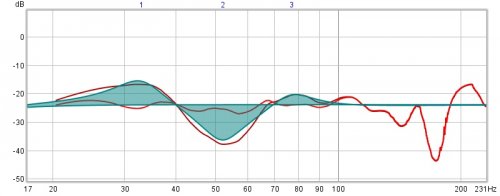castleofargh
Sound Science Forum Moderator
- Joined
- Jul 2, 2011
- Posts
- 10,515
- Likes
- 6,163
vision is our dominant sense, it's using a bigger area of our brain. and then maybe there's also habit, how your room sounds, how you're used to that and now consider it to be how it should sound. so it's very likely that you have enough reference of that room to simply want something as close as possible instead of other fancy simulations. I've told that anecdote a few times, where I used a laptop on the side feeding a bigger screen and I was of course sitting in front of the screen using an external keyboard for a few months. I would often just use the tweeters of the laptop when watching a youtube video or some web radio as background while browsing or ruining my pictures with unskilled post processing. at some point, my brain started to place sound at the screen where the guy in the video was appearing. because I assume, my brain still had more confidence in what I was seeing than in what I was hearing. and there has been so many such examples of brain plasticity, including the guys learning to live with glasses that inverted the image. it's nothing new. what's IMO very interesting is that if I decided to put on my headphone, I never even for a second felt that the sound was off center. my brain somehow had a clear understanding that the laptop sound was a on off weirdness, and that using the headphone was another system with other audio rules.So I tried it out - flat EQ vs headphone compensation. The Headphone Compensation renders a more realistic sound than EQ to flat. Although it's very close.
I also have some extra info on the IEM for HRTF from oratory that I'll post on a GitHub thread.
What's I'm finding is so strange is how your brain works. I did a bunch of testing on my laptop in a cafe between Dolby Headphone Cinema room with a flat EQ and Impulcifer. My tests there made me conclude that I actually preferred the sound signature of the Dolby Headphone and it had a crazy realistic center channel for an artificial HRIR. While Impulcfier did have more accuracy in the rear channels but it just didn't sound right. That was on Friday.
Today, sitting in my actual theater room, where I took the measurements, it's the complete opposite. I don't like the sound of the Dolby Headphone room and the center channel just isn't right. But Impulcifer sounds amazing and like my actual speakers. I'm even enjoying music on it which did not sound right in the cafe.
Psychoacoustics is weird. I suspect my brain knows what my theater room sounds like and is correcting for it. But when I take that same sound into an unfamiliar environment It knows that the center channel should be coming from a distance away too - where as in the cafe I was on a laptop so Dolby's HRIR was sufficient for that.
It makes it really hard to do traditional A vs B testing and figuring out which you prefer. I just didn't appreciate how important the room was and even the visual cues from the speakers in the room etc.
all that to say that something as basic as being in a given room, or having real speakers in your field of view, that can and probably does play a part in what you hear. then there may also be something about the reverb in the room, at a cafe I'm guessing you could perceive enough outside noises to capture a sense of the room's acoustic. it's both amazing and super frustrating to me TBH ^_^.

























